Porous Paving
This course is designed to provide information on all types of porous pavements, including their differences, similarities, maintenance plans, and gen
Sponsored by Invisible Structures, Inc.
There is no audio associated with this presentation.
This course is designed to provide information on all types of porous pavements, including their differences, similarities, maintenance plans, and general benefits. By course completion, the learner should be equipped to decide which porous paving systems are best suited for their projects based on cost, maintenance, aesthetics, ease of installation, functionality, and municipal requirements. This course will also teach you how to calculate LEED points for their projects through the benefits of porous paving.

Photo courtesy of Invisible Structures
Gravelpave2 Porous Paving was used to create functional and ADA compliant pathways throughout the National Garden at the United States Botanic Garden in Washington, DC.
Invisible Structures was the first and is the best solution for porous paving and stormwater management. We provide a beautifully simple answer to a complex challenge. Our grass porous paving, gravel porous paving, underground stormwater storage, erosion control, drainage, and access mats are American-made, earth-friendly and built to last. We also craft confidence and trust by providing a caring, personal experience from a family-owned, service-driven company. Like our products, we provide the strongest support in the industry.
Originally published in Food Engineering
Originally published in January 2021
LEARNING OBJECTIVES
- Define and describe the properties of Porous Paving.
- Assess when to use various applications of porous paving.
- Differentiate the different types of Porous Paving by cost, aesthetics, functionality, maintenance, ease of installation and municipal requirements.
- Explain how to calculate municipal requirements and LEED points.











